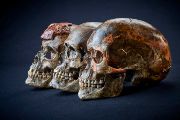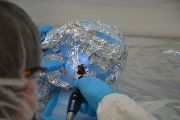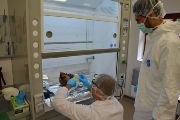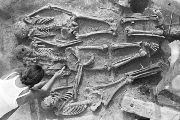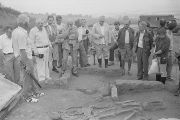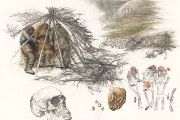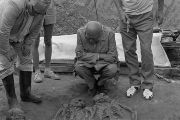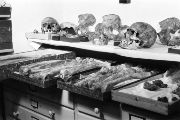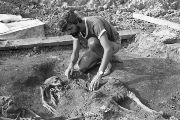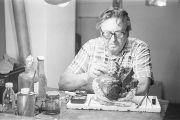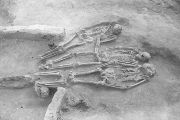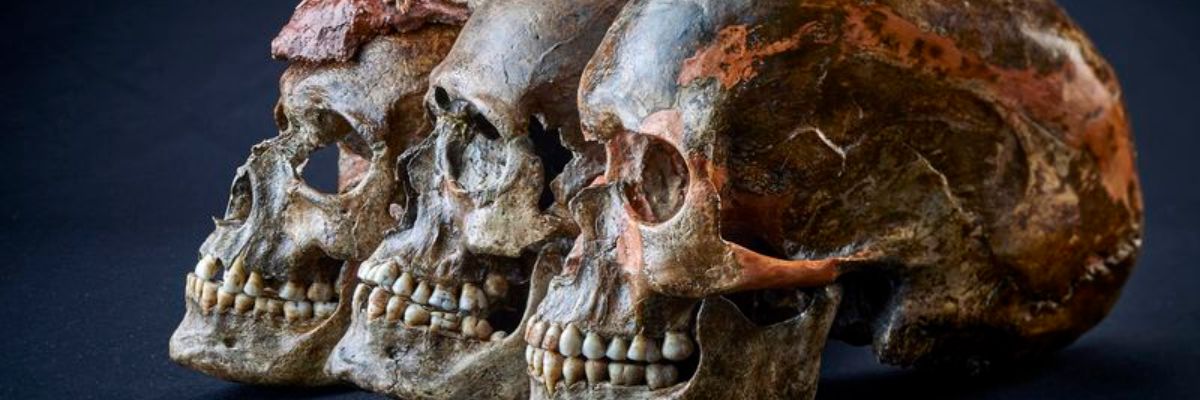
The genetic footprint of hunters from Dolni Vestonice vanished 20,000 years ago
03. 03. 2023
The genetic map of western and central Eurasia changed significantly after the last glacial maximum about 20,000 years ago. Geneticists, together with anthropologists and archaeologists, studied the complete human genome of 356 individuals who lived 50,000–5,000 BCE. The study, published in Nature, also examined remains from the well-known triple burial at the Dolni Vestonice site, which were analysed by experts from the Institute of Archaeology of the Czech Academy of Sciences in Brno.
The analysis of archaic DNA is still yielding new insights. Currently, researchers centred around Cosimo Postha and Svante Päabo, Nobel laureate in paleogenetics, are focusing on how the distribution of populations and their genetic profile changed after the Last Glacial Maximum (LGM), a climatic event that occurred during the ice age about 24,000 to 20,000 years ago (the last peak of the last ice age). Researchers worked with sketches of the “genetic history” of Europe from a previous study of theirs. Now, thanks to new sampling methods, they were able to obtain more complete samples and significantly expand the European genetic tree.
“The Last Glacial Maximum represented a critical bottleneck for European populations. A part of Europe was covered by glaciers and permafrost was encroaching on the territory of present-day Czech Republic, the climate had cooled considerably, and there was greater drought. Groups of hunters-gatherers were changing and moving around while also developing further – perhaps even with new genes,” explains Jiří Svoboda from the Institute of Archaeology of the Czech Academy of Sciences in Brno, who has been involved in the study of fossil finds from Dolni Vestonice, Pavlov, and other studies for the past three decades.
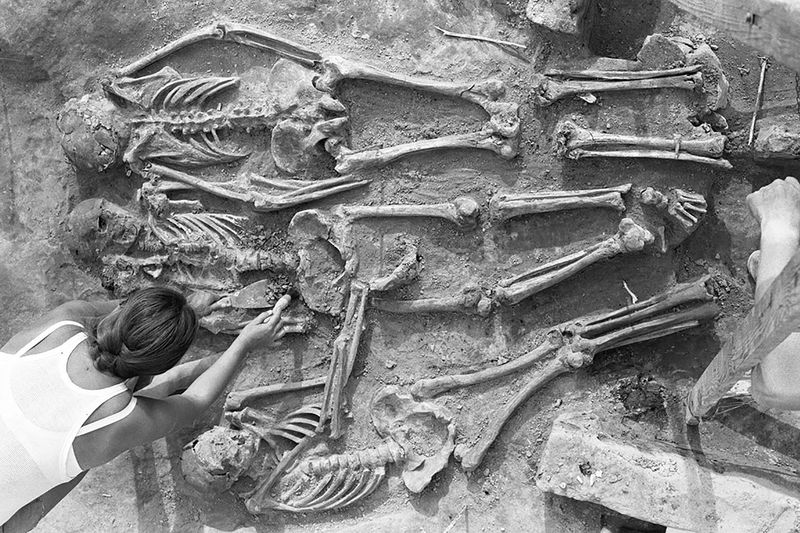
The triple burial excavation site at Dolni Vestonice (1986). Photo: Jiří Svoboda, Archive of the Institute of Archeology of the CAS in Brno.
The Vestonice “cluster” disappeared
It was the remains of three men from the Dolni Vestonice II site that proved to be a missing piece in the genetic map of Europe. A complete analysis of their genomes and comparison with other remains in the new extensive study showed that the genetic trace of our hunters from Dolni Vestonice and Pavlov disappeared after the Last Glacial Maximum.
“The dominant hypothesis we are currently working with is an ecological one – due to the Last Glacial Maximum, the vegetation on the territory of the present-day Czech Republic was thinning and animal herds were migrating, which meant that sources of food were diminishing. It is not yet possible to prove whether other populations were involved as well,” Svoboda adds.
And while traces of the Vestonice cluster disappeared, other populations thrived.
“We identified a new genetic profile of some individuals from the western European Gravettian culture, which differs from their contemporaries in the central and southern parts of Europe, including the so-called mammoth hunters.”
“Their gene pool expanded into northern and north-eastern Europe after the LGM,” Svoboda explains.
Distinguishing between Western and Eastern European hunter-gatherers
Another significant genetic change was discovered by researchers in southern Europe, where migrations and local replacements within human groups, i.e., the exchange and differentiation of genes, were still occurring during the Last Glacial Maximum.
“In the last phase of the research, more analysis was done on samples from Italy, where there are also a lot of anthropological findings. This resulted in the ‘finer-grained’ view of population movements in the Mediterranean,” Svoboda explains.
Overall, the researchers were able to distinguish between Western and Eastern European hunter-gatherers thanks to the more detailed data.
Withstanding the ravages of time and archaeologists alike
When collecting archaic DNA, researchers struggle with the damage to the remains over thousands of years as well as contamination from more recent DNA that can be transferred onto the finds during handling. This must then be separated in the subsequent analyses.
“Additional samples from our fossils were taken in 2017 from the petrous part of the temporal bone, which is the hardest bone of the skull and its internal structure is best protected against the effects of the external environment,” says Sandra Sázelová from the Institute of Archaeology of the CAS in Brno, also a co-author of the international study.
The bones are very valuable, and each sample collection is a destructive process. It is therefore essential to take samples for genetic analysis in a completely clean environment and in as minimum a scope as possible.
“Thanks to microCT images created in collaboration with the Max Planck Institute in Leipzig, we were able to use a 3D model of the temporal bones of all three examined individuals.”
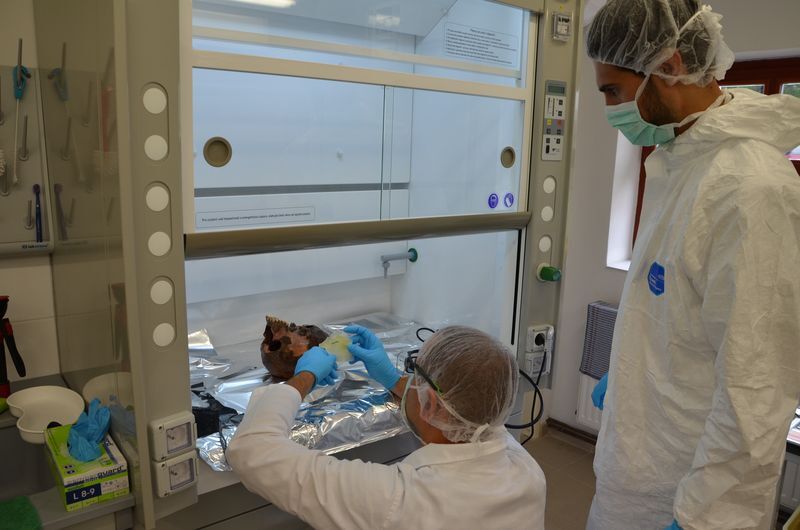
The 3D model of the petrous part of the temporal bone, used to design the sampling probe, held here by Dr. Alexander Stoessel from the Max Planck Institute at the field lab of the Brno Institute of Archaeology of the CAS in Dolni Vestonice. Photo: Sandra Sázelová, Archive of the Institute of Archaeology of the CAS in Brno.
“We were able to print the 3D model and use it to design the sampling probe accordingly to minimise the extent of damage to the surrounding structures of the middle and inner ear, which is thus left for further examination,” Sázelová adds.
Both Sandra Sázelová and Jiří Svoboda were involved in the methodological supervision of the sample collection itself and, as co-authors, gradually expanded upon the context of the “Czech” burials and corrected the resulting interpretations in relation to other finds, especially isolated human remains, which are also found in the cultural layers of the sites under study.
The international study, entitled “Palaeogenomics of Upper Palaeolithic to Neolithic European hunter-gatherers” and published on 1 March 2023 in Nature, is available here.
Prepared by: Press Department, CAO of the CAS
Translated by: Tereza Novická, Division of External Relations, CAO of the CAS
Photo: Archive of the Institute of Archaeology of the CAS in Brno
Read also
- A trapped state: The pandemic impact on public attitudes, trust, and behavior
- Aerial archaeology: Tracing the footsteps of our ancestors from the sky
- Archaeologists uncover ancient finds along Prague Ring Road
- Our microbiome largely depends on what we eat, says microbiologist Michal Kraus
- The ABCs of writing: Why did its invention mark a turning point for humankind?
- We learn, remember, forget… What can memory actually do? And can we outsmart it?
- New Center for Electron Microscopy in Brno opens its doors to global science
- The hidden lives of waste: What can we learn from waste workers and pickers?
- A unique lab is hidden right beneath Prague’s Vítkov Hill
- Renewables are a strategic investment in European security, scientists say
The Czech Academy of Sciences (the CAS)
The mission of the CAS
The primary mission of the CAS is to conduct research in a broad spectrum of natural, technical and social sciences as well as humanities. This research aims to advance progress of scientific knowledge at the international level, considering, however, the specific needs of the Czech society and the national culture.
President of the CAS
Prof. Eva Zažímalová has started her second term of office in May 2021. She is a respected scientist, and a Professor of Plant Anatomy and Physiology.
She is also a part of GCSA of the EU.
